26 GILBERT BOY ENGINEERING
A good torch can be made by
nailing an old tin can to a pole about 6 feet long; stuff the
can with old rags or waste; pour over these a little oil and
light with a match. This will give you a torch that will burn
long enough to send any message of reasonable length.
WIGWAGGING BY SEARCHLIGHT
The beam of a searchlight may be used for wigwagging at night
and in the U. S. Navy it is very frequently used. The rays of
the light are directed vertically and swing from right to left
to indicate the dots and dashes of the General Service Code.
All motions are the same as in the single flag Wigwag System.
27
Chapter III
GENERAL INFORMATION AND
ADVICE TO SIGNALISTS
Now that you have become
familiar with the General Service Code and one method of
sending it, a few rules can be given that will be of help in
all systems of signaling. Many bits of this advice may sound
military, but you may well take heed of it for it is essential
to practical signaling more so if you are a Boy Scout or some
day have occasion to work with a military organization.
Signaling, like all professions, has its established terms and
a correct plan of procedure. To gain a full knowledge of
signaling it is necessary that you become accustomed to
handling a message correctly.
A Signal Station
consists of one or more signalmen operating as a unit and
ready at all times to send or receive a message. The station
can be either temporary or stationary.
The Home Station is
station to which you are assigned.
The Sending Station
is station sending message.
The Receiving Station
is station receiving message.
To Call a station,
it is the usual plan first to attract attention. This is done
in the various signal systems as follows :
1. Wigwag system: Succession of dots and dashes.
2. Semaphore system : Waving flags at attention.
3. Sound system: Succession of dots (or toots).
4. Heliograph system : Long and short flashes.
5. Ardois system : Display of four white lights.
6. Radio system -
. - . - .
7. Buzzer system: Station call letter.
28 GILBERT BOY ENGINEERING
8. Telegraph system: Station
call letter.
9. Flash light system: Short flashes or dots.
In addition to attracting attention, if the call letter or
letters of the station you desire to communicate with are
known, the signal representing them should be made at
intervals. It is very important that each signal station has a
call of one or two letters. Any letters can be adopted such as X or XY. This is essential for
the reason that you may be facing and within signal distance
of two or three stations at times and want to send only to one
of these, individually. Note: If call letter is unknown, use
the letter A.
The Receiving Station
always acknowledges your call by making R and its call letter.
After this acknowledgement you are ready to proceed with the
message.
THE MESSAGE
The plan of the message varies
at times, according to the organization; however, all messages
are divided in a general way as follows:
1. Preamble.
2. Address to.
3. Text of message or body.
4. Address from or signature.
The preamble of the message is reserved solely for use of
signalmen dealing with the message. The preamble or
introduction of a message consists of the serial number of
message and time message is handed in at station and accepted
for transmission.
All stations use serial numbers in handling messages,
beginning with number one and so on up for each twenty-four
hours, after which a new series is started. Next comes the
call letter of sending station or office of origin, the
signalist's personal signature (all signalmen must use a
personal signature as, J. J.
29 GILBERT SIGNAL
ENGINEERING
for John Jones, etc.) the
check of message (number of words in body of message), and the
class of message.
To arrive at the exact number of words in the body of a
message this rule is followed: Include in count the address
after TO and all
words in body, including the address following FROM, but do not count FROM or SIG. if that term is used
by signalists. Abbreviations, figures and names of cities and
states should be counted as one word, for example : C X K (get
reply) is one word; South Chicago, Illinois, or So. Chi. Ill.,
is counted as two words ; and one-quarter as one word.
The message usually indicates whether it is official business
(OB) or official message (OFM) as collect, or paid message,
urgent, etc.
The Address of a message should always contain enough words or
information to insure its delivery.
The Address FROM
should convey the same amount of intelligence.
The Double dash - . . . -
of the General Service Code is
always used between the preamble and address TO; between the
address and text; and between text and from or signature.
The following is a message handed in at a signal station at
Brown's farm (call letter B) at 10 A. M. to be transmitted to
station X Y (Smith's Crossing). Signalist John Jones (J. J.)
takes the message:
(To) Bill Smith,
Smith's Crossing.
Get your gang together and meet me at the Stony Creek Bridge
at 2 P. M., I will bring the bunch, don't forget your skates,
ice is one-quarter foot thick.
(From) Harry Brown, Brown's Farm
Get reply to this message. (C X K)
30 GILBERT BOY ENGINEERING
After Jones checks the message he finds it contains 38 "signal
words." He numbers it 8 (as it is the eighth message he has sent
that day from his station) and decides to send it by single flag
wigwag. After getting attention of station X Y he proceeds to
send as follows :
8 ( - - -. . ) interval or front TEN front
A. M, front, B (Brown's Sta. call) front, C.K. 38
(message check) front, JJ. (Jones' signature)
front, OF (official message) front (-
. . . - )
(double dash)
TO: front Bill-Smith-Smiths-Crossing-get-ur-gang-together and-meet-me-at-t-Stony-
Creek-bridge-at
2 (. . - - -
)-P.M.-I-will-bring-t-bunch-don't-forget-ur-skates-ice-is (- . . . - ) (double dash used before
fraction)1 (.
- - - - ) (- - . . - .) (indicating fraction bar) 4 (.
. . . - )
foot thick (- . . . -) (double
dash)-SIG.-Harry-Brown-Browns-Farm - C X K (get reply) - (.
- . - . -) (cross) or (. . . - . - ) (meaning end of work).
Station XY acknowledges receipt of message by O.K. or . - .
(R). The receiving station has a record of this message
as sent above and the transaction is complete.
Of course, if you are not an expert signalman, to lessen
liability of errors, it is best to spell out all numerals,
fractions and abbreviations.
A message handed in at a signal station should always be
looked over, for an omission of one word may change the
meaning of the whole message. The advantage and importance of
checking by sender and in the recheck by the receiving station
can be seen at once.
Both sending and receiving stations should record on the
message what system was used in handling it. The date should
also show, although the serial numbers, in a measure, indicate
31 GILBERT SIGNAL
ENGINEERING
the dates. As you will recall,
they are changed every twenty-four hours.
In military organizations all messages are considered strictly
confidential.
DUTIES OF A SIGNAL UNIT
You have been told that a
signal station consists of one or more signalmen operating as
a unit. Where there is more than one, each must have his
duties to perform; therefore, it is advisable where three boys
are operating a sending station to know just what each boy's
duty is.
First Boy or Caller takes charge of the
messages, checks same and makes proper entries. When message
is ready to send he
calls the word or group to
Second Boy or Sender whose duty it is to
send the message as called. His other duty is to see that his
sending equipment is always in good condition.
Third Boy or Answer Reader reports
signal as being answered and watches for interruptions from
receiving station, using binoculars when necessary. Note :
Should four boys be operating a station, the fourth boy will
act as a messenger.
INTERRUPTION OF MESSAGES
At times signal units have a
good many messages on hand to dispose of and have these
messages in course of transmission when a very important
urgent signal is handed in. It then becomes necessary to make
the Break Signal, which is the attention sign by all systems.
As soon as the break is acknowledged, proceed with the more
important message.
The Answer Reader should always be on the lookout for
32 GILBERT BOY ENGINEERING
signs of error from receiving
station and report to sender what portion of message has been
missed.
The duties of these boys at a receiving station are similar.
First Boy, Reader (with binoculars), reads each letter, sign
or numeral, calling out group on ending of each word, etc.
Second Boy, Answerman, stands by to make any necessary
interruptions and to answer signal as required.
Third Boy, Writer, writes on signal form each group or signs
as called out by the reader.
The first boy must be an expert on signals, for it is his duty
to take charge of the signal unit. When his station is acting
as a receiving station, it is his business to read correctly
all messages. He should enforce a certain amount of discipline
around the station, and not allow any unnecessary talking,
etc., while signalmen are operating,
INTERVALS
The intervals of the General
Service Code were purposely omitted in Chart 2 so as not to
confuse you with their secondary meanings. They are as follows
:
| Interval |
Double
Interval |
Triple
Interval |
| . - . - |
. . . . . .
(same as
period) |
. - . - . -
(same as cross) |
Intervals are expressed as follows in the various systems:
|
Interval |
Double
Interval |
Triple
Interval |
| 1. Wigwag |
front motion |
(twice)
|
(three
times) |
| 2. Semaphore |
flags
crossed or
machine closed |
2
chop-chop signals |
3
chop-chop signals |
33 GILBERT SIGNAL
ENGINEERING
|
Interval |
Double
Interval |
Triple
Interval |
3. Sound
(Bell)
(Whistle) |
. . . (short
taps)
long blast |
. . . .
. .
. . . .
. . |
. . .
. . . .
. - .
- . |
4. Radio
Flashing light
Heliograph
Buzzer and
Telegraph |
(space) |
. . . . . . |
. - . -
. |
| 5. Ardois |
. - .
- |
(twice)
|
(twice)
{three times) |
CODE TIME
You have been informed that,
when a message is handed in at station and accepted for
transmission, a record of the time is made and sent in the
preamble. This code time serves to show how long a message has
taken to pass through the hands of the signalmen.
In order to save time to spell out or to send code time by
numbers, the Letter Clock System is sometimes used.
Chart 4 gives you the letter clock, which is an ordinary clock
face with letters placed against the hours. The twelve hours
are denoted by the first twelve letters of the alphabet,
omitting the letter J.
These letters stand not only for the hours but also for
periods of five minutes; for example: A would be one o'clock and
five minutes past any hour, B
two o'clock and ten minutes past any hour, and so on. AA would mean one five, AB would mean one ten. To
denote intermediate minutes the letters RSWX are used in every
period of five minutes. Thus MR
means one minute past twelve; MS means twelve two.
The hands of clock shown on your chart show time to be four
minutes past six o'clock and the letters that denote that time
34 GILBERT BOY ENGINEERING
LETTER CLOCK
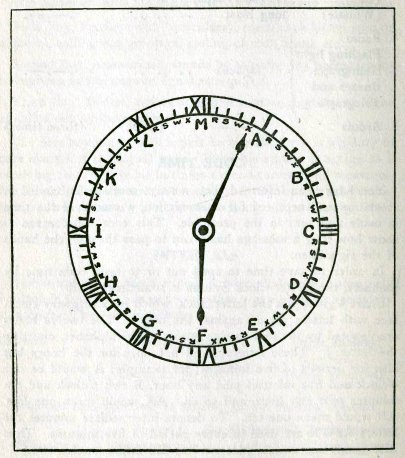
CHART 4
35
GILBERT SIGNAL ENGINEERING
are FMX, reading in code time 6.04 either A. M. or
P. M. as case may be.
Should a message be handed in at a station at exactly noon or
midnight it would have to be recorded by code at one minute
past to avoid confusion. The message handed in at noon would
be put in code as MR
P.M. and at midnight MR
A.M.
36 GILBERT BOY ENGINEERING
Chapter IV
SEMAPHORE SYSTEM
The word semaphore is derived
from the Greek word seema, meaning a sign, and phero, to bear
or carry. This system is sometimes called brachial telegraph,
meaning telegraphing with arms,
THE SEMAPHORE MACHINE
The two-arm semaphore machine
is used in permanent stations only, as it is not a portable
piece of signal apparatus.
The semaphore machine is authorized for use of the U. S. Army
at fixed stations and is used on all the larger ships of the
U. S. and other navies.
This semaphore machine has two arms or vanes for forming the
characters of the code and a third arm or indicator displayed
on right of sender (on left as viewed by receiver) as a point
of reference to motion.
Semaphore machines are usually about 8 feet high, with arms of
2 1/2 or 3 feet. The arms are operated by two levers which are
placed on the machine at average height of elbows of the body.
An additional lever operates the indicator arm.
The machine is painted black or gray, while arms and indicator
are colored a light yellow.
For night use the machine is fitted along entire length of the
arms with electric lights. The indicator is used by day only
to indicate direction of sending; at night, instead of the
indicator, a red electric light is used at top of machine.
This light is screened to rear, and if machine is facing
receiving station squarely it will
37 GILBERT SIGNAL ENGINEERING
SEMAPHORE MACHJNE
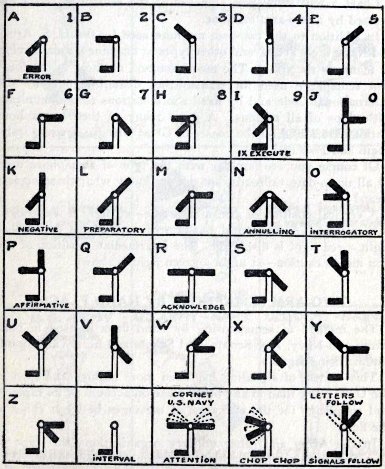 CHART 5
CHART 5
38 GILBERT BOY ENGINEERING
not be seen. Semaphore
machines are mounted on a pivot so as to turn in any
direction.
Chart 5 will show you alphabet of the semaphore code expressed
by a two-arm machine.
In addition to the two-arm machine used by the U. S. Army and
Navy there are several other types of machines, some having as
many as six arms. The most common of these is the four-arm
semaphore used for transmitting distant signals by the
International Code and by fixed shore stations to communicate
with ships of all nations. A great many of these semaphore
stations are found on the coasts of Great Britain, France,
Italy, Spain and Portugal.
Of course you are familiar with the type of semaphore used by
all up-to-date railroads, but do you know what these signals
mean?
A vertical position of arm means safe at night a white light
is displayed. A horizontal position of arm means danger at
night a red light is displayed. The intermediate position of
the arm means caution at night a green light is shown.
TWO-ARM SEMAPHORE BY HAND FLAGS
The method of semaphoring by
hand flags is used in both Army and Navy, Boy Scouts, Girl
Scouts and nearly all organizations using signals.
This system of signaling has been more highly developed in the
U. S. Navy than in any other place on account of its rapidity
and simplicity for the exchange of messages between ships of
the fleet.
In the Army and other military organizations this type of
signaling is somewhat limited on account of short range. The
usual range for hand flags of 18-inch size is about one mile
with the naked eye, and is always dependent upon your
background
39 GILBERT SIGNAL ENGINEERING
TWO-ARM SEMAPHORE
 CHART 6
CHART 6
40
GILBERT BOY ENGINEERING
TWO-ARM: SEMAPHORE
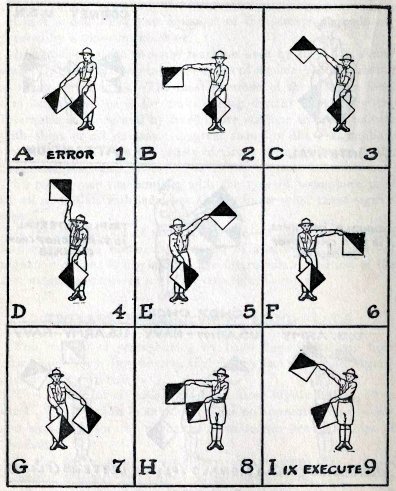 CHART 6
CHART 6
41
GILBERT SIGNAL ENGINEERING
TWO-ARM SEMAPHORE
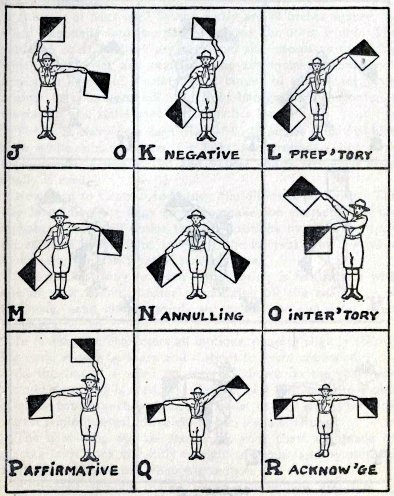 CHART 6
CHART 6
42
GILBERT BOY ENGINEERING
TWO-ARM SEMAFHORE
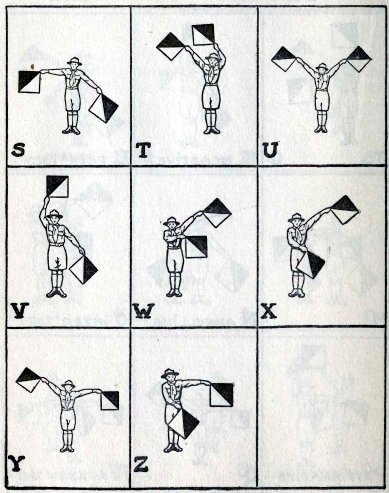 CHART 6
CHART 6
43
GILBERT SIGNAL ENGINEERING
and the light. Much greater
distance is possible, of course, with use of a telescope.
The size of flags used by the Army are 18 inches square,
divided diagonally into two parts one red, the other white.
The field and coast artillery use the same size except as to
colors, which are scarlet and orange. The arrangement is a
9-inch square in center of scarlet and a border of orange for
work against dark background. For light backgrounds the order
is reversed. The staffs used are 24 inches long.
The U. S. Navy uses flags from 12 to 15 inches square of blue
with white square center for light backgrounds. For dark
backgrounds, a flag of red and yellow colors, arranged
diagonally is used.
Now turn to Chart 6 and study the different positions. The boy
is holding the flags so as to make the characters of the
alphabet. You will notice that all positions by hand flags are
the same as by machine, excepting the interval, which is made
by crossing flags in front of sender's legs.
The quickest way to learn semaphoring is to practice with one
of your friends. After memorizing all the characters of the
code, send simple words to each other and later short
messages.
In making the characters all motions, pausing slightly
following each, should be sharp and distinct to avoid
confusion.
At the end of a word the interval shown on the chart and
already described is used. At the end of a sentence the double
interval, two chop-chop signals, is made. At the end of the
message a triple interval, three chop-chop signals, is used.
The chop-chop signals shown on your chart are made by placing
both arms vertically to right of sender and by working flags
up and down in a chopping motion.
Additional symbols found in your chart are attention or
cornet, numerals follow, signals follow and letters follow.
44 GILBERT BOY ENGINEERING
This attention signal is, of
course, used to get attention, and is made by agitating the
letter R.
The numerals follow signal is made by crossing flags over head
and is used to designate the fact that you intend to use the
numerals which are expressed by secondary meanings of your
alphabet letters A to J as shown on chart. The numerals are
made by semaphore in this way by all organizations except the
Navy, where regulations require them to be spelled out in
full. The interval must be used following each numeral.
Signals follow is made by reversing the letter L and is used to designate
the fact that a code message or secondary meanings follow.
Letters follow is used only by U. S. Army and Navy and is made
the reverse of the letter T.
It signifies letters will be used to spell words.
A great many of the conventional signals and abbreviations
given in your General Service Code can be adopted for
semaphoring. To indicate an error in semaphore the letter A is used as in the
General Service Code. As A
already has a secondary meaning (the numeral one) it is
necessary to agitate your flags a little.
The conventional interrogatory signal is made by agitating the
letter O.
In sending an official message by semaphore the same rules are
followed as given in preceding chapter.
No punctuation marks are given in the semaphore code and if
used they must be spelled out.
Do not slur your letters in semaphoring but make them exactly
as shown on charts. However, now that you are becoming a real
signalman, it will not do you any harm to know that experts at
semaphore signaling sometimes deviate from the regular
motions. To explain this in a practical way, spell the
following word without moving your right arm, after mak-
45 GILBERT SIGNAL
ENGINEERING
ing the first letter of word MANILA. Spell BED also with right or
left arm only.
In semaphore signaling when sender makes an "end of word"
sign, the receiver acknowledges this, if the message is
understood, by extending his arms horizontally and by waving
them until the sender does the same and message is finished.
By machine, the receiving station fixes his call letter
stationary until the message is received and understood and
then the machine is closed.
46
Chapter V
SOUND AND FLASH LIGHT SYSTEMS
SOUND SYSTEM. As early as the 17th century
attempts were made to establish communications by artillery
and musketry firing. The system of sound signaling, came into
use at this time.
The sound system is based on the General Service Code and is
used more commonly by the ships of the Merchant Marine and the
U. S. Navy. However, due to its aptness to cause confusion, it
is rarely used by ships except in cases of emergency, such as
in fogs or when a breakdown of other signal apparatus occurs
and only in regions unfrequented by other vessels.
Messages are sent by the sound system by use of steam whistle,
foghorn and bell.
When the steam whistle is used, messages are spelled out,
except in the case of the U. S. Navy, which uses the Navy
Code.
The intervals by all methods of the sound system are expressed
as previously given in Chapter 2, under intervals. You will
notice a difference in signals for interval in case of the
whistle or bell.
In the case of the whistle one long blast represents the dash
and a short one for dot ; but in use of the bell a continuous
sound cannot be made, therefore it is necessary to use two
strokes to make a dash and one stroke for a dot.
SOUND SIGNALS BY BUGLE
The Navy has lately adopted a
code for signaling by bugle or trumpet; this code was invented
by a high school student of West Roxbury, Mass. The code is
given you in Chart 7. No
47 GILBERT SIGNAL
ENGINEERING
U.S. NAVY BUGLE CODE
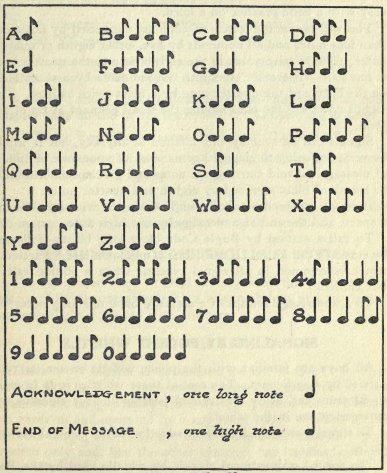 CHART 7
CHART 7
48
GILBERT BOY ENGINEERING
special musical knowledge is
necessary to sound the characters of the alphabet and
numerals, except to acquire what is known by players of wind
instruments as the "lip," which comes very easy with a little
practice on a horn.
You will notice the letters of code are expressed by not more
than four notes and all numerals by five, either eighth or
quarter notes. The relative value of the eighth note to the
quarter note is one-half. Therefore an eighth note is made by
a short blast on the horn and the quarter note by a blast
twice as long. The eighth notes are the ones having the small
pennant at tip of the stem.
Signals can be sent by this method in any key, but it would be
very confusing to change key or pitch of your tone in middle
of message. Avoid slurring the notes and give special
attention to length of blast signified by eighth and quarter
notes.
Intervals between words in Bugle Code are made by allowing a
space, and the end of a message by one high note.
To call a station by Bugle Code blow long blasts followed by
station's call letter. If call letter is unknown, use the
letter A which is common in all signal systems when a station
call is not known.
To acknowledge receipt of a message blow one long note.
SIGNALING BY POCKET WHISTLE
All boys are familiar with the
police whistle or similar type carried by Boy Scouts. The cost
of these whistles runs from 15 to 50 cents and every boy
should possess one for signaling or emergency use in the
woods.
To signal a message by pocket whistle use the General Service
Code.
The special conventional signals by whistle used by the Boy
Scouts are as follows:
49 GILBERT SIGNAL
ENGINEERING
1. One long blast means
"Silence," "Attention," "Look out for my next signal," also
used in approaching a station.
2. Two short blasts mean "All right"
3. A succession of short, sharp blasts means "Rally," "Come
together," "Close in."
4. A succession of long, slow blasts means "Go out," "Get
farther away" or "Advance," "Extend," "Scatter."
5. Three short blasts followed by one long one from scout
master calls up the patrol leaders i. e., "Leaders come here."
6. Three long blasts means "Danger," "Look out."
7. A succession of alternating long and sharp blasts means
"Mess Call."
All whistle signals should be obeyed as quickly as possible,
no matter what work you may be doing at the time.
FLASHING OR OCCULTING LIGHT SYSTEM
The equipment used to send
messages by this system is the electric blinker, operating
with a telegraph key, and the lantern or searchlight equipped
with shutters.
THE BLINKER
The electric blinker is
authorized for use in the U. S. Navy and is also used by many
other navies and merchant vessels. The electric lamp is
usually placed at the peak of the foremast or on yardarm and
operated by a key from bridge of ship. Incandescent lamps, 110
volts, are used. These are used as a night system only and,
like the other systems, has its disadvantages, especially in
foggy weather when used in a locality where a group of ships
are at anchor displaying their many lights.
50 GILBERT BOY ENGINEERING
For sending messages by blinker
the General Service Code is used.
THE ACETYLENE LANTERN
The standard night signal
equipment used by the Army is the acetylene lantern.
Acetylene is a pure hydrocarbon gas, and is produced in the
signal lantern by bringing water into contact with calcium
carbide. The illumination resulting is about 1900 candle power
and, with the exception of the searchlight, the acetylene
lantern furnishes the most powerful form of night signaling.
The range obtainable by this type of lantern is as much as ten
miles with naked eye, and with a 30-power telescope the
flashes can be read for thirty miles.
On dark and cloudy days this lantern can be used for day
signaling at a distance of one-half to three-quarters of a
mile.
SEARCHLIGHT SIGNALING
The most powerful night system
used is the searchlight, which is equipped with a shutter and
operated by a key. This method of signaling is used by coast
artillery corps and most commonly by the Navy. While it is
essentially a night system, it is also used in day sending,
and ships at sea in ordinary weather have been able to send
messages for distances up to ten miles.
THE HELIOGRAPH
The heliograph is an instrument designed for the purpose of
transmitting signals by means of the sun's rays.
The sun being the most powerful light in existence, heliograph
flashes can be sent farther than by any other method of visual
signaling. When the day is clear and the sun's rays intense,
 The
Science Notebook
The
Science Notebook The
Science Notebook
The
Science Notebook





